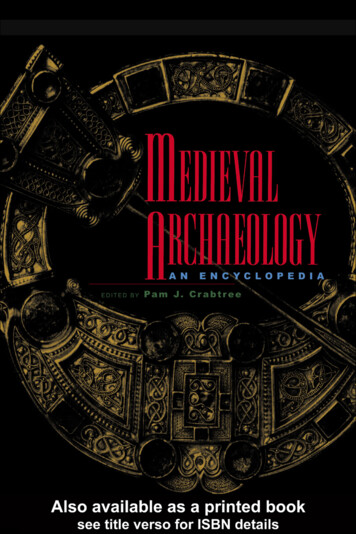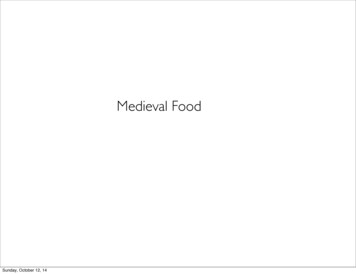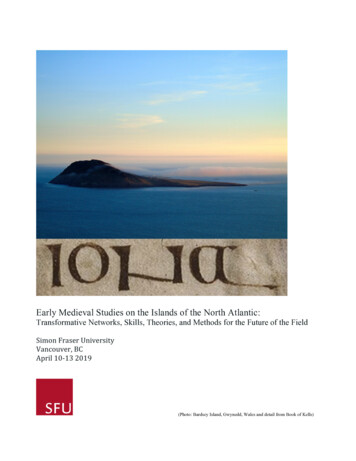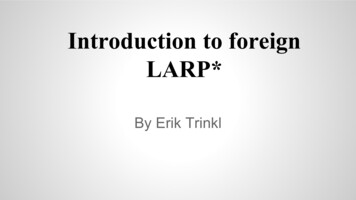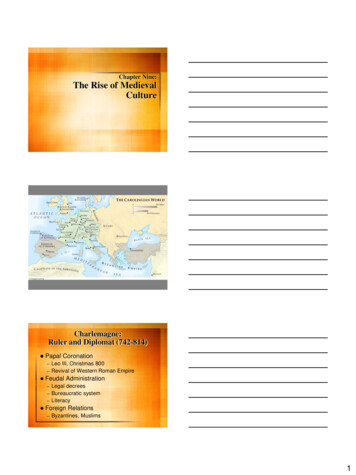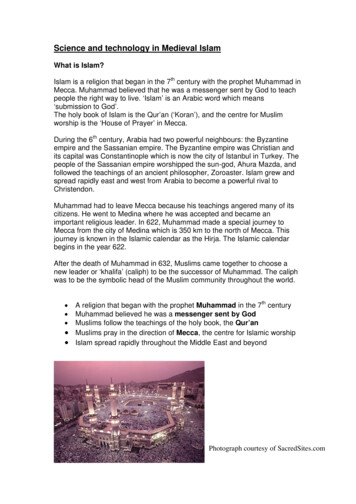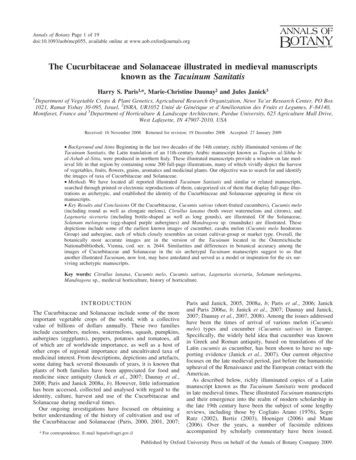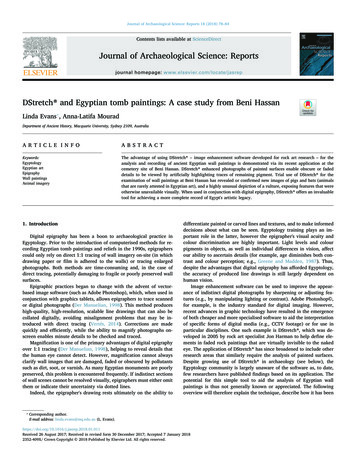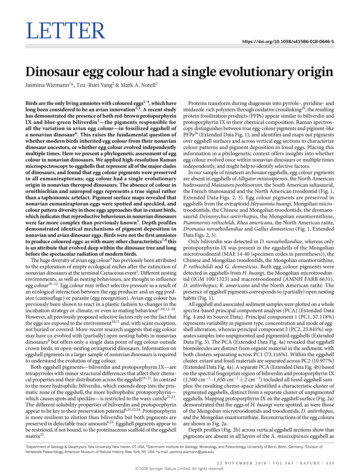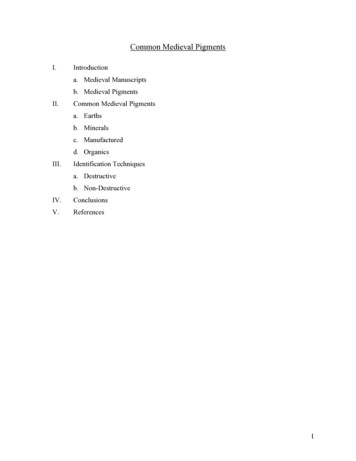
Transcription
Common Medieval PigmentsI.Introductiona. Medieval Manuscriptsb. Medieval PigmentsII.Common Medieval Pigmentsa. Earthsb. Mineralsc. Manufacturedd. OrganicsIII.Identification Techniquesa. Destructiveb. Non-DestructiveIV.ConclusionsV.References1
I. IntroductionWithin the period of time formerly known as the “Dark Ages” there existed a productionof numerous objects of art containing brilliant and glorious colors that illuminated the medievalmind and so deeply reflected the content they embellished. This glimmer in the medieval worldowes much of its brilliance to simple elements such as clay, natural minerals and insects,common ingredients in the pigments used in the production of medieval illuminations. Thepigments used in medieval manuscripts varied by geographic location, time period and materialsavailable. This paper offers an introduction to the common medieval palette used in illuminatedmanuscripts before 1500. The different methods that have been utilized for the identification ofthese pigments will be discussed, with encouragement to further develop and research nondestructive methods of testing.A. Medieval ManuscriptsSoon after the primary sacred text in the Christian church came to be called the Bible, or“the book”, many manuscripts based on this content were produced (Diringer 21). All booksduring this period were written by hand, until the invention of the printing press in the 15thcentury. Book illumination, or the illumination of manuscripts, is the art of embellishingparchment manuscript books with painted pictures, ornamental letters and designs. The technicalterm for “illuminated” refers to being “light up” with bright colors. John W. Bradley writes,“Perfect illumination must contain both colors and metals”(Diringer 21).There is not a clear distinction between illumination and illustration, though it has beensuggested that illumination refers solely to beautifying the object of devotion and illustratingdeals with clarifying the contents of a text. Ancient examples of book illustration include theRamesseum Papyrus and the Book of the Dead. Both Egyptian works dated as early as the 20thcentury B.C. The earliest illuminated manuscript extant of Western Christianity is theQuedlinburg Fragment from Northern Italy dating back to the 4th century A.D. (Diringer 22).Illumination in the full sense of the word has been commonly accepted to originate in Europearound the 6th c. A.D (Diringer 23). The elements discussed are some of the more commonpigments used in medieval manuscript illumination in the period before 1500.2
B. Medieval PigmentMost of the information on pigments from the medieval period comes from technicaltreatises on technology and painting from the 1st to the 15th centuries. Included in the descriptivetechniques of Roman wall painting found in Vitruvius’ De Architectura and in Pliny The Elder’sNaturalis Historia are some characteristics and various uses of certain pigments. The wellknown medieval study of technology, the Mappae Clavicula, was produced around1130 A.D.and in addition to containing the first recipe for soap, these manuscripts include procedures forthe making and mixing of pigments (Smith et al.). Other well known sources include the treatiseby Theophilus, a German monk who wrote an exhaustive account of the techniques of almost allthe known crafts of the early12th century in De Diversis Artibus and Cenino Cennini whoproduced a treatise on painting in the early 15th century, the Libero dell'Arte.Pigment is defined as the coloring agent in paint. Pigments come from various sources ofanimals, plants and natural minerals. The powdery pigment is mixed with a binding medium(which can range from honey to earwax) into a workable medium that can be applied as paint.Common media used as a binder were egg-tempera and gum-arabic. Early scribes prepared theirown pigments, and their recipes differed in the techniques and materials used, making it difficultto replicate an exact color. There is evidence that in the early 13th century some scribes beganpurchasing ingredients from stationers and some standard colorants began to emerge.Medieval manuscript illuminations today have some preservation issues which have beendealt with differently over the ages. A main issue is the consolidation of flaking pigments. Animportant key to the proper treatment of illuminations is the identification of what pigments arepresent. For example, some consolidants will affect the visual appearance of pigmentsdifferently, making them more opaque or translucent. The identification of pigments is also usedto form a better understanding of the way in which the original artist was working, matchingcolors for restoration, identifying compatibility with chemical treatment, and identifyingauthenticity. This identification can be done in a destructive way, requiring a sample of thepigment for analysis, or in a non-destructive manner that does not require a sampling from thework. Cheryl Porter stresses the need to develop more straightforward and non-destructive testsfor pigment identification than currently exist (2001). A goal of this paper is to provide anintroduction to common medieval pigments, encourage the use of non-destructive identification3
and highlight the importance to research more extensively non-destructive techniques forpigment analysis.II. Common Medieval PigmentsCommon Medieval pigments can be broken into four categories: Earths, minerals,manufactured and organic. Included in the following breakdown are the common name of apigment, physical and chemical characteristics, means of identification and any specialsignificance in the Middle Ages.A. EarthsThe earths have been described as the “workhorses of the palette.” They are not bright orflashy, and were inexpensive (Porter). The main compounds were iron, clay, manganesedioxide, alumina, and silica. Categorization of these pigments refers to the origin of thematerials being “dug from the earth.” This category includes the siennas and umbers as well asthe ochres, which were “evidently not attractive to the illuminators of the later Middle Ages” asstated by Ross (6).Terre n earth is derived from the minerals glauconite and celadonite and is one of theoldest pigments. Their colors range from neutral yellow green to pale greenish gray to darkmatte olive green. In the Middle Ages green earth could also have beenknown as prason. One of the most well-known uses for green earth wasin the underpainting of flesh (Fig. 1) as described by Theophilus andCennini. Cennini also mentions the use of green earth for bole, statingthat the ancients “never gilded except with this green.” He also describedterre verte as a “fat” color, by which he most likely meant the powderabsorbed much of the binder media when mixing (Feller, vol. 1).The pigment is easily identifiable under the microscope due tothe characteristic appearance of celadonite and glauconite. Theparticles are greenish gray, mottled and striated. A destructiveFigure 1. detail of TheVirgin and Child withSaints Dominic andAurea showing greenearth /palette/palette greenearth.htm)4
chemical test for the detection of ferrous ions can be done by treatment with concentrated acidsolution to positively identify this pigment.B. Natural MineralsUltramarineNa8-10Al6Si6O24S2-4Ultramarine in Cennini’s words is, “a color illustrious, beautiful, and most perfect,beyond all other colors; one could not say anything about it, or do anything with it, that itsquality would not still surpass ” (Hoeniger 2). Ultramarine is famous for having been the mostexpensive pigment. It was more expensive than gold during the Renaissance and also highlyexotic because of its origin. First used in 6th century Afghanistan, the pigment was used mostextensively in the 14th and 15th century illuminated manuscripts and Italian panel paintings. Itwas often reserved for the cloaks of Christ and the Virgin (Douma). The pigment is made fromthe precious stone lapis lazuli. The stone was also used as a medieval cure for melancholy. Thesource of the mineral in the Middle Ages was from the Badakshan mines in Afghanistan. Eventhe best lapis lazuli has impurities of calcspar and iron pyrites. Thirteenth century recipesdescribe the best methods for extraction. The powdered lapis lazuli was mixed with pastille ofpine resin, mastic, wax or linseed oil boiled together. The mass was soaked, then kneaded in lyeuntil the blue color was extracted (Ross 11). The purest, deep blue was extracted in the firstbatch and sold for the highest price. As the process was continued, the subsequent batches ofpigments were slightly less pure; the final batch being a transparent blue gray called ultramarineash.There have been few cases of ultramarine turning a gray or yellowish-gray from“ultramarine sickness.” It has been proposed that atmospheric sulfur dioxide and moisture arethe cause for this discoloration (Feller vol. 2).Ultramarine shows a high stability to light, but is readily decomposed by acids.Hydrochloric acid will rapidly destroy the blue color and is a useful but destructive chemicalidentification test. Heating to redness was an early identification method to determineultramarine from azurite, which would turn black around 300 C.5
Under the microscope natural ultramarine usually shows crystalline mineral impuritieswhich are mainly colorless particles mixed in with the blue crystals of lapis lazuli. This aids indistinguishing natural ultramarine from the synthetic, first made in 1828 (Ross 11).Infrared photographs of Ultramarine are also used to identify the pigment in a nondestructive way. In normal light a painting depicting the Virgin and child shows Mary’s robespainted in ultramarine as a deep, dark blue. In an Infrared photograph the same robes appearlight because of the high reflectance of ultramarine for infrared light (Fig. 2). Color infrared filmis also used to distinguish ultramarine from azurite as discussed in the section on identificationmethods.Figure 2. Detail from a triptych by Duccio. National Gallery, London, No. 566.The image in panchromatic (left) and infrared (right) light.Azurite2 CuCO3 · Cu(OH)2Evidence has shown this pigment was used most often from the 14th to 17th centuries andis often considered the most important medieval pigment because of its frequent use. Azurite isa copper carbonate prepared by grinding the lump form, then washing and levigating to separatethe color from impurities. Coarsely ground azurite produces a dark blue, while finely groundazurite produces a lighter tone.Azurite is stable to light and normal atmosphere, but is known to turn green, reverting tothe chemically similar malachite. This is commonly seen in many medieval works containingazurite. The pigment gives off water and carbon dioxide when heated to 300 , turning black withthe formation of cupric oxide. It also darkens when warmed by alkalis and with exposure to6
sulfuric fumes. Azurite is recognizable microscopically by its crystal morphology, color andrefractive properties with little difficulty unless the sample is very finely divided (Feller vol. 2).Under the microscope azurite crystalline fragments appear pale, colorless or slightly purplishblue. It is very similar to ultramarine and can be distinguished from the pigment by heating to300 or using color infrared film to test for reflectance.OrpimentAs2S3Orpiment is also known as king’s yellow and is found in natural and artificial form. It isdifficult to differentiate between natural and artificial orpiment, except that the artificial form ismore finely ground. The first mention of this form of orpiment is by Cennini in the 15th century.Orpiment has been identified in objects of the 31st century B.C. in Egypt, some suggesting thatthe pigment was used in Egyptian cosmetics despite its toxicity. The Chinese used the toxicproperties of Orpiment to repel insects from book rolls, as described in 5th century treatises(Feller vol. 3). The pigment is described as a lemon or canary yellow but can range from goldento brownish yellow. Orpiment shows severe color loss after exposure to ozone in the absence oflight, converting to arsenic trioxide. The pigment decomposes slowly in water, and is soluble inhydrochloric acid and sodium hydroxide.Orpiment is incompatible with lead and copper pigments and will darken them when inclose proximity. The pigment outgases, and the orpiment vapors will creep over to the lead colorand revert it to a lead-gray color. This process can creep at a couple of inches in a few months.It also has a corrosive action on binding materials, often decaying and coming away from theparchment (Ross 16). Orpiment’s incompatibility is mentioned in the Mappae Clavicula fromthe 12th century, specifically referring to its corruption of white and red lead. By the 15th centuryit was known that verdigris and orpiment should not be used together. Eastern sources from the11th century state it was common to mix orpiment and indigo to create a green color. In Europeorpiment was later mixed with azurite to make a green commonly used in medieval miniatures(Feller vol. 3).One can identify between orpiment and the similar arsenic disulfide realgar with adestructive burn test. Both realgar and orpiment produce arsenic trioxide when heated, but onlyrealgar burns with a blue flame (Feller vol. 3). Orpiment can also be confirmed with a test forarsenic. Under the microscope orpiment particles have high refringence and appear as needle7
shaped crystals. This may suggest other pigments such as litharge, chrome yellow and strontiumyellow, but all these will test negative for arsenic.Silver and gold leafingGold was often used in gilding manuscripts with decorative borders or laid in gold leafform. First, a base adherent or bole was put on the desired areas. Next, the gold lead wascarefully positioned on the page. It was allowed to dry and the excess was removed with a toollike a soft brush. Silver was used less often because it easily tarnishes due to oxidation.Artificial gold pigment is known as mosaic gold, arium musicum, or ormolu. Also known asstannic sulfide [SnS(2)] it was manufactured to resemble mineral gold. This scaly yellowcrystalline powder was used as a pigment in bronzing and gilding wood and metal work as well.Another artificial metal pigment was purpurinus. This artificial tin sulfide was prepared bymelting equal parts of tin and mercury and adding sulfur and sal ammoniac as described intreatises of the 14th century (Ross 20).C. Manufactured PigmentsLead White2PbCO3 Pb(OH)2This pigment has been used since classical times, and was prepared by suspending stripsof lead above vinegar or urine in a vase, sealing it and burying it in a dung heap for several days.After a few days the artist scraped off the crust formation on the lead and ground it for use. Thepigment is poisonous when ingested or inhaled, but medieval ladies found it to be a usefulcosmetic nonetheless. Lead white tends to darken when exposed to air and is incompatible withverdigris and orpiment. Bone white was often an alternative choice when working in proximitywith these two pigments (Ross 2, 4).Lead white is a basic lead carbonate soluble in dilute nitric and acetic acid. Lead whiteshows remarkable permanence and is unaffected by light. Hydrogen sulfide in the air can causethe pigment to turn black perhaps because of the formation of lead dioxide. The black formationcan be converted to a more stable state using hydrogen peroxide, as shown in the treatment ofcertain wall paintings (Feller vol. 2. 72). A positive test for the presence of lead is usually8
acceptable for identification, usually done with water and KI to form the precipitate PbI2.Optical characteristics include high opacity and high density.Red leadPb3O4The orange red tetroxide of lead is produced by heating white lead until the heat expelswater and carbon dioxide from the crystals in the form of gas. The pigment was called “minium”and from its frequent use in the small independent illuminations found in manuscripts, theseilluminations became known as “miniatures.” Thinned down red paint was also used as a writingink for rubrics (the headings on medieval pages). Dilute nitric acid turns red lead into brownlead peroxide, which is the last stage to which white lead may be oxidized. Under great heat redlead becomes a light violet, and when cooled again it becomes a yellowish red (Feller vol. 1).Lead-Tin YellowType I Pb2SnO4By gently roasting white lead the pigment known as litharge or lead monoxide isproduced. The addition of tin produces two types of lead-tin yellow. The more commonly usedis type I, and was mostly used before the 18th century. Forms of lead-tin yellow are mentioned inthe Italian manuscripts of the late Middle Ages which refer to is as “massicot” and Cennini refersto the pigment as “giallorino” (Feller vol. 2, 70). Under a microscope there is a distinctdifference in particle morphology between type I and II. The pigment is toxic because of thehigh lead content, is unaffected by alkalis. It blackens with hydrogen sulfide promoting theformation of lead sulfide. Lead-tin type I exhibits compatibility with almost all pigments andwas commonly mixed with verdigris, azurite and white lead (Feller, vol. 2, 72). It isdistinguished from chrome yellow by testing for CrO4 and Pb. Chrome yellow should bepositive in both tests, while lead-tin yellow will test negative for CrO4 and positive for lead.VerdigrisCu(OH) 2 · (CH3COO)2 · 5 H2OInfamous for being destructively reactive, this popular pigment consisted of the basicacetates of copper in which the amount of acetate determined the greenness of the product.9
Verdigris was produced by the corrosion of strips of copper with vinegar fumes. After thepigment was scraped from the plate, it was mixed with wine and allowed to thicken. Salt greenwas made from smearing the copper with wine, honey or vinegar and calcined salt beforecorroding. If the copper was smeared with soap before being suspended it was known as“rouen” (Ross 19). Also known as Spanish green, the pigment is incompatible with white leadand orpiment as well as many media and surfaces. Verdigris is destructive and will degradecellulosic materials and parchment. In some Persian miniature paintings the presence of saffronappears to mitigate the harmful effect of the verdigris. The major chemical mechanismresponsible for this behavior is the saffron solution serving as a buffer. Research by Barkeshlishows results that verdigris mixed with saffron did not char the paper support, and charringoccurred only where the pure verdigris existed.The color ranges from green, green-blue to blue and it exists in two types: basic andneutral verdigris. The neutral form seems to be the preferred verdigris pigment in the MiddleAges. Basic verdigris is formed when acetic acid vapor, water vapor and air act upon copper andcopper alloys. Neutral verdigris, or verde eterno, is neutral copper acetate formed when basicacetates are dissolved in acetic acid, as recommended by Cennini. The basic pigment iscomposed of blue-green crystals that dissolve entirely in water and decompose when boiled.They dissolve in acetic acid, producing a dark green solution (Feller vol. 2).Neutral verdigris particles are composed of tabular crystals with rhombic and hexagonalfaces, resembling large chunks. The basic blue particles resemble bundles of long, fine needles.Verdigris reacts destructively with its binding medium and binding surface. It iscommonly known that the reflectance of verdigris pigment changes as it dries. Freshly appliedverdigris differs from day old pigment and three month old pigment. Verdigris mixed withsulfur containing pigments in an aqueous media may darken due to the formation of coppersulfide. A test of verdigris pigment under three months of high illumination of fluorescent,xenon lamps and mercury vapor lamps showed no change, supporting the paints stronglightfastness, and also suggesting the brown discoloration that has been observed is not causedby light damage (Feller vol. 2).10
VermillionHgSVermillion is formed from red mercuric sulphide obtainedfrom cinnabar (Fig. 3), the principle ore of mercury, or artificiallyby heating sulphur and mercury together. The best cinnabar isknown to originate in Spain. Artificial Vermillion was commonknowledge by the 15th century. To produce this dye differingproportions of sulfur and mercury were put in a well-luted (sealedwith clay) jar and heated until a blue vapor emitted or one heardFigure 3. Mineral cinnabar(www.webexhibits.org/pigments)the noise of the “two uniting.” Vermillion was frequently mixedwith red lead and sometimes with yellow in medieval painting (Ross 5). In D. V. Thompson’sopinion “no other scientific invention has had so great and lasting effect upon painting as theinvention of this color.” (Ross 8). The only defect of this color is that it is slightly toxic and alsocan darken to a black substance. Since Roman times it has been known that specimens ofvermilion darken when exposed to light. Some tests have shown that impurities in the alkalipolysulfides used to "digest" the pigment lead to this instability. This catalyzes the transition ofthe red to black. It has also been found that the darkening of vermilion occurs mainly inpaintings using egg tempera binder (Rose).D. OrganicOrganic pigments refer to pigments whose components are found in nature, but not inmineral form, such as plants or insects. Lamp black is made from the soot produced fromburning linseed or other oils, pitch, candles, or resin. It was used in ancient Egyptian pottery,and was frequently mixed with gum and used for ink. Vine black, a charcoal made fromgrapevine twigs, was one of “the most perfect colors” according to Cennini. Saffron is anorganic yellow made from the dried stamens of Crocus plants, then infused with glaire or gumwater. Less popular pigments made from organic matter include yellow lakes, blue turnsole anddragon’s blood.Lac and KermesThe term “lake” in the Middle Ages applied to red pigments that were extracted fromorganic dyestuffs. The term now refers to any dye-based pigment. Lake comes from the Indian11
“lac” or “lakh” meaning “a hundred thousand” referring to the large number of Laccifer laccafound on tree branches. These insects secreted a sticky resin that was harvested then ground intoa fine powder. The powder was boiled in urine or lye with the addition of alum, then the liquidwas poured off and the remaining matter was allowed to dry and harden. A binding medium wasadded to the pigment, and the former insects then contributed their brilliant color to sacrediconography in various illuminations.Kermes is produced in a similar way from the dried bodies of the female Kermes vermiliothat are found in great numbers on the scarlet oaks of Europe, the best quality growing in theOrient (Ross 6). Cennini notes that kermes was a highly prized dye in 15th century Florence. Itproduced a dark hue resembling blood and kermes is the linguistic root for the English word“crimson.” A similarly colored pigment was madder, a natural dye from the root of the Rubiatinctorium. It was more common than kermes, and not as highly prized (Ross 6).Brazil or VerzinoThese pigments were prepared from the wood of the Caelsalpinia braziliensis, alsoknown as brazilwood, and produced a splendid rose color. The color was obtained by boilingwood shavings in lye or urine and then soaking them in hot egg white or hot lye. Powdered alumwas added for more transparent colors. To make a more opaque color required that the mix beprecipitated onto a base of travertine, marble dust, chalk white lead or powdered eggshells. Thetreatises writers gave a lot of attention to this color. Despite being known as an inferior dye itwas probably more popular because it was cheaper, more abundant and easier to use than otherred dyes (Ross 8).Indigo and WoadThese are organic blues from the Indigoferra and Isatis tinctoria plants. Treatises writersdistinguished the two by referring to indigo as “bagadel indigo.” Besides this distinction indigoand woad were basically interchangeable. Woad plants are indigenous to Europe, and wereintroduced in larger quantities in the 17th century. The pigment was made from the froth or“flower of woad” that rose to the top of the dyer’s vat. It was skimmed off and combined withany variety of white bases (Ross 14). The pigment has been used since ancient times, perhaps bythe early inhabitants of Britain to dye their skin blue (Ross 13). The first mention of the tradingof indigo is seen in a12th century accounting book of a European merchant. Synthetic indigo was12
not produced until 1870. The difference between natural and synthetic indigo is determined bythe amount of the isomer indirubin present in the pigment. The isomer can be removed byboiling the substance in ether, resulting in pure indigo. An ancient test for indigo is described inthe 1st century Historia Naturalis stating, “Indigo is tested on hot charcoal, for pure indigo givesa flame of a fine purple color.” (Feller, vol. 3, 87)Indigo is characterized as having a good light resistance, but there have been examples ofchanges in the spectral reflection of Japanese indigo exposed to “soft white” fluorescent lamps(Feller, vol. 3, 87). Indigo is insoluble in water, dilute alkali solutions and acids. The dye ismore readily soluble in cholorform and may bleed in an oil medium. Mixing orpiment andindigo to produce shades of green was seen in the Islamic world of the 14th century and Cenninialso mentions this as a popular practice in 15th century Florence.Under the microscope indigo particles are very fine and opaque. The refractive indices ofindigo and phthalocyanine blue are similar, so a bleach test with Chlorox (NaOCl) is used todistinguish the two. The blue color in indigo will bleach out, and the phthalocyanine blue willnot be affected (Lab, 147).These pigments are only some of the more commonly used in illuminated manuscriptsproduced before the 16th century. Since the 16th century many artificial pigments have beenproduced. As more technological advances in testing become available to scientists morepigments from illuminated manuscripts are being analyzed. The analyses suggest that medievalilluminators used varying colorants from very creative sources in their paint, some of which haveyet to be identified. Analysis of a sample from a 15th century German manuscript suggested oneof the red colorants was Rhubarb (Scott et al.). Krekel and Polborn reported the discovery of apigment, named lime blue, or blue verditer that has not yet been reported in chemical literature(2003).Some pigments are easily confused by the naked eye and can even appear similar under amicroscope. Over the years methods and chemical tests have been developed to distinguishpigments from one another. These methods include those that require an actual sampling of thepigment and tests that can analyze the pigment in a non-destructive way.13
III. IdentificationThere are many different characteristics that are used to distinguish pigment particlesfrom one another. The crystal or particles’ morphology, its optical properties, the chemicalcomposition, and the molecular structure are all characteristics used for identification, or rather,steps to confirmation since conclusions should depend on more than one method in determiningan unknown. The conservator is limited by what instruments are at his/her disposal and howmuch time is available, as well as what type of sampling is allowed. Identification is importantin deciding what materials to use for consolidation of flaking paint, testing to see if a treatmenton the parchment or paper is incompatible with the painting media, as well as understanding anyreactions between the pigments with the binding medium or parchment.A. Destructive MethodsMicrochemical tests are done to detect a particular element of functional group. In thisprocess the sample paint chip is tested with various solvents, other elements, or by heating. Apositive test for the presence of an element is usually more dependable than a negative test thatonly proves the absence of the element. Positive tests can also mean different things. Anunidentified orange pigment that shows a positive KI test for lead could be white lead tinted withearth pigments or a whiting medium mixed with litharge. All tests should first be done with aknown sample to minimize error. Flowcharts can be used to identify a samplethrough a series of tests, the results ofwhich guides one to the appropriatepigment (Fig. 4). Some charts may beinconclusive, including the possibility thatthe unknown is not one of the options, orthe pigment is not purely one type, but acomplex mixture of many types.Microscopic examination ofpigments is used to identify physicalFigure 4. Flow chart for the identification of blue pigments.(Lab Manual, 149)14
characteristics such as particle shape, surface structure, opacity and color. Kohler illumination isthe standard used in optical tests for birefringence, in measuring refractive indices, and analyzingthe appearance of particles in polarized and transmitted light. The refractive indices of pigmentsare a common property used in identification. The refractive index can be defined as the speedof light in one material divided by the speed of light in another material (usually air, water or avacuum). By definition the refractive index of a vacuum is 1, air is 1.0008 and water has anindex of 1.330.In X-ray diffraction the sample is scraped and attached to a thin glass rod smeared withVaseline. It is mounted in the center of an X-ray camera, which is lined with photographic film.As x-rays pass through the sample, the layers of atoms in a crystalline substance reflect wavetrains in phase with each other. This
of numerous objects of art containing brilliant and glorious colors that illuminated the medieval mind and so deeply reflected the content they embellished. This glimmer in the medieval world owes much of its brilliance to si
